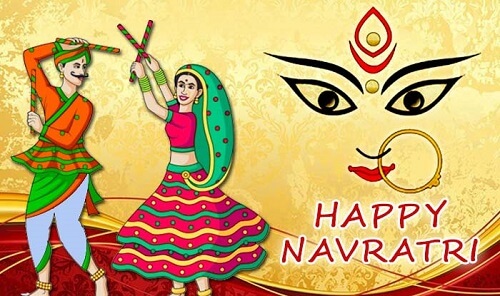08 Oct Navratri special / Fasting for Navratri

Navratri is around the corner. This navratri special post is mainly for those who want to keep fasts, do’s and don’ts. This festival is celebrated to worship the divine forms of Goddesses Durga (first 3 days), Lakshmi (next 3 days) and Saraswathi (last 3 days). These 9 days are supposed to be auspicious period for Hindus. In Maharashtra, Gujarat and some North Indian states, many people observe fast during the 9 days as offerings to these deities.
There is no hard and fast rules that one should observe the fast throughout the nine days; some people observe only for the first / middle / last 3 days. Those who are very strict consume only milk and fruits, some have only one meal thorough the day with the items mentioned below while some avoid only non-veg foods and alcohol. Some fast during the day by eating only foods that are allowed* and eat normal food in the night. It all depends on one’s will power.
*Though each family has their own rules & traditions for including or avoiding certain ingredients in their food during fast, most follow the basic pattern given below:
Foods to be avoided during Navratri Vrat:
Non-vegetarian food, onion and garlic, rice (and rice products), wheat (including rawa and maida), all lentils and its by products like besan, table salt**, turmeric, mustard seeds, fenugreek seeds, coriander powder, chilli powder & asafoetida (hing / perungayam)
**Table salt is highly processed and so is not recommended. Instead rock salt / black salt / sendha namak or upvaas ka namak / is included. Rock salt or sendha namak is considered pure as it is not subjected to processing.
Foods that can be included during Navratri Vrat:
Vrat favourites are: Sago (Sabudana / javvarisi), sama millet (vari chawal, bhagar), kuttu (buckwheat), singhara atta (water chestnut flour) & Rajgira (amaranthus), vegetables like potato, sweet potato, arbi (colocasia root / taro root), yam (chenai), pumpkin, cucumber, all fruits and fruit juices, all dry fruits & nuts, sugar, honey, jaggery, milk and milk products (curd, ghee, home-made paneer, butter, cream & khoya).
Apart from these, one can use peanuts, oil (peanut oil), cumin (jeera), green chillies, green cardamom, rock salt (sendha namak), coconut, coconut milk, souring agents like tamarind, kokum & lemon juice.
Some families add tomatoes because basically tomatoes are fruits, while some do not. In some States in North India, vegetables like bottle gourd (lauki / dudhi / suraikai), carrot are allowed. And similarly, cloves, cinnamon, ajwain & black pepper are consumed in some families. Basically, it all depends on the family traditions. Since it is the time to eat light and cleanse yourself from within, too much spicy food is not advised.
From this list above, we can see that the foods that can be included are more than the ones that should be avoided. It bursts the myth that it is difficult to maintain fast and that fasting food is boring. With the options available in front of us, we can cook up healthy, tasty and interesting food for fast.
I’m attempting to follow this fast for the next 9 days. I have decided to include one thali per day with 2 main course and 1 dessert using the ingredients mentioned above. There are many more foods like fried pakoras & puris and many sweets using milk & sugar that can be included which I have avoided principally to make it healthy. Dairy is avoided by default.
If you wish to follow, I’ll be posting one thali recipe for each day in the next nine days. Thali for each Day will be published the previous day so that you can be prepared with the ingredients, in case you are also planning to observe fast during this festival.
Since Navratri for 2018 starts on 10th October, recipe posts will start on 9th. Irrespective of whether you observe fast or not, you can still try these healthy recipes whenever you find time.
Tips:
- Do not starve yourself. Starving creates craving and we end up over eating. Dry fruits and nuts can be had in moderation to avoid starving.
- Consuming fresh fruits, fruit juices, coconut water, kokum juice, etc helps in satiating the hunger and keeping the body hydrated.
- Most important thing to remember during these festivals is to keep our hearts pure. By observing fast we try to cleanse our body. It is equally important to cleanse our mind & hearts too. Removing negative thoughts and directing our energies towards righteous actions, help cleanse the mind & hearts.
Happy Navratri and Healthy Fasting.
You may check for Thali recipes for all days of Navratri here




Sujal Patwardhan
Posted at 09:38h, 09 OctoberHi Aunty,
Awesome recipe!
ramag
Posted at 10:47h, 09 OctoberThanks Sujal